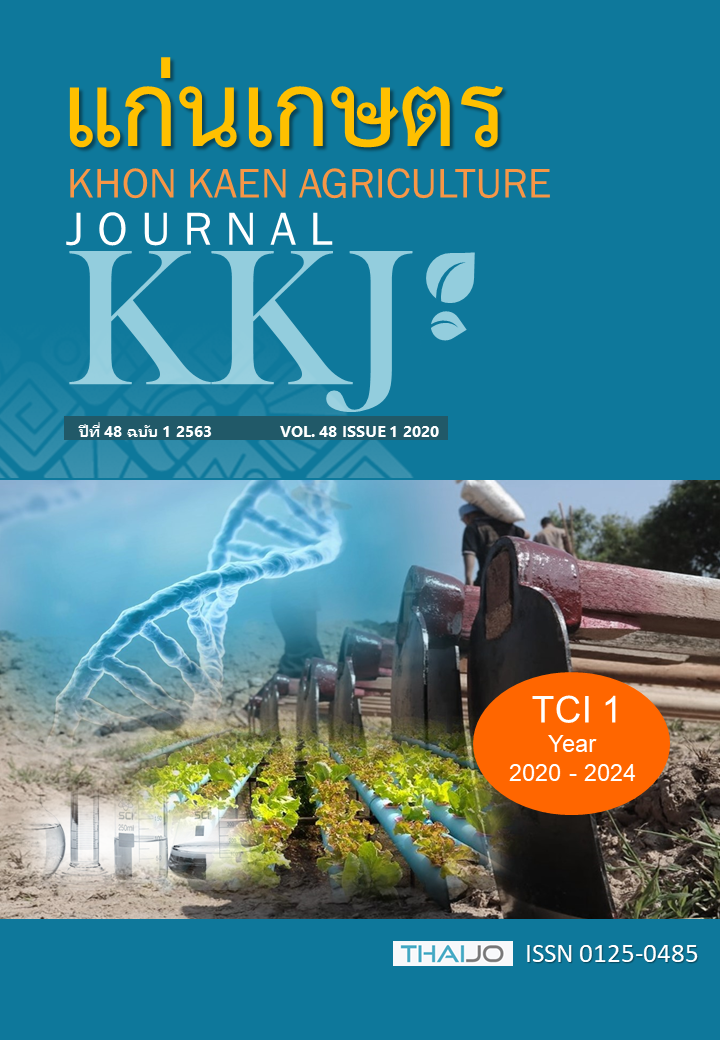วสัดปุระสานสำหรับการพอกเมลด็พนัธุ์
Main Article Content
บทคัดย่อ
วัสดุประสาน คือ หนึ่งในองค์ประกอบของการพอกเมล็ดพันธุ์ มีบทบาทสำคัญคือเป็นสารเชื่อมยึดระหว่างเมล็ดพันธุ์และวัสดุพอกให้ยึดติดกันจนเป็นเมล็ดพอกที่สมบูรณ์ การพอกเมล็ดพันธุ์ให้ประสบผลสำเร็จต้องมีความรู้ความเข้าใจเกี่ยวกับคุณสมบัติเบื้องต้นของวัสดุประสานแต่ละชนิด โดยทั่วไปวัสดุประสานมีทั้งชนิดสามารถละลายได้ในน้ำหรือสามารถละลายได้ขึ้นอยู่กับค่า pH และประเภทไม่ละลายน้ำ และแต่ละประเภทจะถูกนำมาประยุกต์ใช้เพื่อวัตถุประสงค์การพอกเมล็ดที่แตกต่างกัน ปัจจุบันวัสดุประสานถูกนำมาใช้พอกเมล็ดมีทั้งชนิดเดี่ยว ชนิดผสม และประเภทการค้าในระดับอุตสาหกรรมเมล็ดพันธุ์ อย่างไรก็ตาม ถึงแม้จะมีหลายประเภทให้เลือกใช้ แต่มีข้อควรคำนึงถึงคือ การเลือกชนิดของวัสดุประสานให้เหมาะสมกับชนิดของเมล็ดพันธุ์และชนิดของวัสดุพอกเพื่อผลสำเร็จของการพอกเมล็ดพันธุ์ ดังนั้น เพื่อเพิ่มแนวทางการตัดสินใจเลือกใช้วัสดุประสานที่ถูกต้อง รวมถึงเพิ่มองค์ความรู้ทั่วไปที่เกี่ยวข้องกับวัสดุประสาน ในบทความนี้จึงได้นำเสนอเรื่อง ประเภททั่วไปของวัสดุประสาน การเลือกใช้วัสดุประสานที่เหมาะสมต่อการพอกเมล็ดพันธุ์ คุณสมบัติทั่วไปและการนำไปใช้ประโยชน์ของวัสดุประสาน คุณสมบัติการนำพาสารออกฤทธิ์ และลักษณะการตรวจสอบคุณภาพของวัสดุประสานหลังการพอกร่วมกับเมล็ดพันธุ์
Article Details
เอกสารอ้างอิง
จักรพงษ์ กางโสภา และ บุญมี ศิริ. 2557ข. ผลของชนิดสารพอกเมล็ดต่อความงอก และความแข็งแรงของเมล็ดพันธุ์ยาสูบ. แก่นเกษตร. 42(3): 283-292.
จักรพงษ์ กางโสภา และ บุญมี ศิริ. 2558. ศักยภาพของการใช้ carboxymethyl cellulose และ hydroxypropyl methylcellulose เป็นวัสดุประสาน สำหรับการพอกเมล็ดพันธุ์ผักกาดหอม. แก่นเกษตร. 43(ฉบับพิเศษ 1): 268-273.
Anbarasan, R., P. Srimathi, and A. Vijayakumar. 2016. Influence of seed pelleting on seed quality improvement in redgram (Cajanus cajan L.). Legume Research. 39(4): 584-589.
Ashland. 2014. PVP Polyvinylpyrrolidone Polymers Intermediates, solvents, monomers, polymers and specialty chemicals. Available: https://goo.gl/QLatFO. Accessed Feb. 6, 2017.
Kadajji, V.G., and G.V. Betageri. 2011. Water soluble polymers for pharmaceutical applications. Polymers. 3(4): 1972-2009.
Kaewkham, T., P. Chitropas, A. Wongcharoen, R.K. Hynes, J. Kangsopa, and B. Siri. 2016. Effects of polymers as a main component of coating formulations on quality and effects of stability of cucumber seeds. Khon Kaen Agri. J. 44(4): 703-712.
Madsen, M.D., K.W. Davies, C.J. Williams, and T.J. Svejcar. 2012. Agglomerating seeds to enhance native seedling emergence and growth. J. Appl. Ecol. 49: 431-438.
Mvila, B.G., M.C. Pilar-Izquierdo, M.D. Busto, M. Perez-Mateos, and N. Ortega. 2015. Synthesis and characterization of a stable humic–urease complex: application to barley seed encapsulation for improving N uptake. J. Sci. Food Agric. 96: 2981-2989.
Olivera, M.E., L. Ferrari, S. Araoz, and E.B. Postulka. 2017. Improvements on Physiological Seed Quality of Festuca arundinacea Schreb by Encrusting Technology: Products and Storage Effects. Res. J. Seed Sci. 10: 33-37.
Pedrini, S., D.J. Merritt, J. Stevens, and K. Dixon. 2017. Seed Coating: Science or Marketing Spin?. Trends in Plant Science. 22(2): 106-116.
Prakash, M., G.S. Narayanan, S. Padmavathi, and B.S. Kumar. 2015. Standardization of flyash for seed pelleting in sesame. Agric. Sci. Digest. 35(3): 187-190.
Ramesh, K.S., and R. Muthukrishnan. 2015. Impact of organic seed pelleting on seed germination and seedling development in okra and chilli pepper. I.J.S.N. 6(3): 480-483.
Ramzan, N., N. Noreen, Z. Perveen, and S. Shahzad. 2016. Effect of seed pelleting with biocontrol agents on growth and colonisation of roots of mungbean by root-infecting fungi. J. Sci. Food Agric. 96: 3694-3700.
Shashibhaskar, M.S., K.S. Vinutha, S. Nagabhushan, N. Vasudevan, and V. Ramanjinappa. 2012. Seed quality as influenced by seed pelleting and containers during storage in tomato. Plant Archives. 12: 1101-1108.
Sikhao, P., A.G. Taylor, E.T. Marino, C.M. Catranis, and B. Siri. 2015. Development of seed agglomeration technology using lettuce and tomato as model vegetable crop seeds. Sci Hort. 184: 85-92.
Srimathi, P., N. Mariappan, L. Sundaramoorthy, and M. Paramathma. 2013. Effect of organic seed pelleting on seed storability and quality seedling production in biofuel tree species. J. Hortic. For. 5(5): 68-73.
Sun, D., A. Xue, B. Zhang, X. Xue, J. Zhang, and W. Liu. 2016. Enhanced oral bioavailability of acetylpuerarin by poly(lactide-co-glycolide) nanoparticles optimized using uniform design combined with response surface methodology. Drug Design, Development and Therapy. 10: 2029-2039.
Zoubari, M.G. 2015. Water-insoluble polymers as binders for controlled release matrix and reservoir pellets. Doctoral dissertation, Freie Universität Berlin, Germany.


